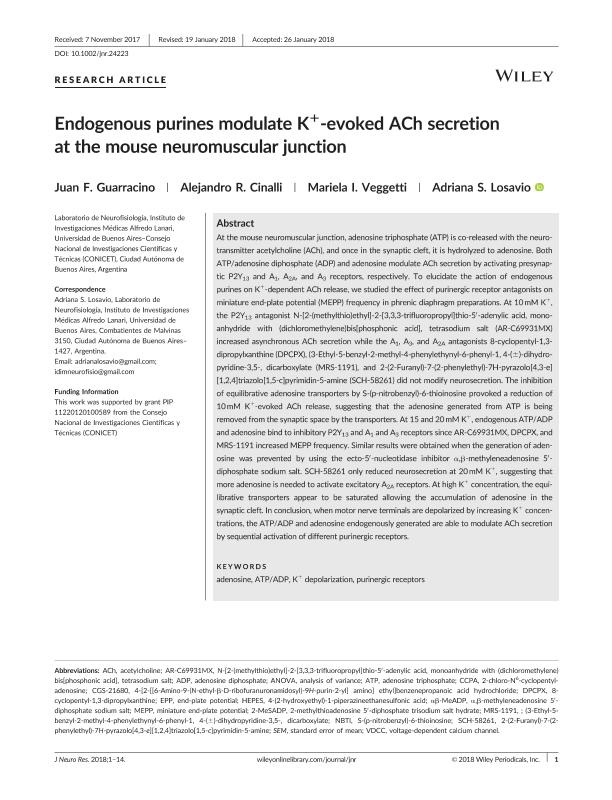Artículo
Endogenous purines modulate K+-evoked ACh secretion at the mouse neuromuscular junction
Guarracino, Juan Francisco ; Cinalli, Alejandro Raúl
; Cinalli, Alejandro Raúl ; Veggetti, Mariela Iris
; Veggetti, Mariela Iris ; Losavio, Adriana Silvia
; Losavio, Adriana Silvia
 ; Cinalli, Alejandro Raúl
; Cinalli, Alejandro Raúl ; Veggetti, Mariela Iris
; Veggetti, Mariela Iris ; Losavio, Adriana Silvia
; Losavio, Adriana Silvia
Fecha de publicación:
06/2018
Editorial:
Wiley-liss, Div John Wiley & Sons Inc
Revista:
Journal of Neuroscience Research
ISSN:
0360-4012
Idioma:
Inglés
Tipo de recurso:
Artículo publicado
Clasificación temática:
Resumen
At the mouse neuromuscular junction, adenosine triphosphate (ATP) is co-released with the neurotransmitter acetylcholine (ACh), and once in the synaptic cleft, it is hydrolyzed to adenosine. Both ATP/adenosine diphosphate (ADP) and adenosine modulate ACh secretion by activating presynaptic P2Y13 and A1, A2A, and A3 receptors, respectively. To elucidate the action of endogenous purines on K+-dependent ACh release, we studied the effect of purinergic receptor antagonists on miniature end-plate potential (MEPP) frequency in phrenic diaphragm preparations. At 10 mM K+, the P2Y13 antagonist N-[2-(methylthio)ethyl]-2-[3,3,3-trifluoropropyl]thio-5′-adenylic acid, monoanhydride with (dichloromethylene)bis[phosphonic acid], tetrasodium salt (AR-C69931MX) increased asynchronous ACh secretion while the A1, A3, and A2A antagonists 8-cyclopentyl-1,3-dipropylxanthine (DPCPX), (3-Ethyl-5-benzyl-2-methyl-4-phenylethynyl-6-phenyl-1, 4-(±)-dihydropyridine-3,5-, dicarboxylate (MRS-1191), and 2-(2-Furanyl)-7-(2-phenylethyl)-7H-pyrazolo[4,3-e][1,2,4]triazolo[1,5-c]pyrimidin-5-amine (SCH-58261) did not modify neurosecretion. The inhibition of equilibrative adenosine transporters by S-(p-nitrobenzyl)-6-thioinosine provoked a reduction of 10 mM K+-evoked ACh release, suggesting that the adenosine generated from ATP is being removed from the synaptic space by the transporters. At 15 and 20 mM K+, endogenous ATP/ADP and adenosine bind to inhibitory P2Y13 and A1 and A3 receptors since AR-C69931MX, DPCPX, and MRS-1191 increased MEPP frequency. Similar results were obtained when the generation of adenosine was prevented by using the ecto-5′-nucleotidase inhibitor α,β-methyleneadenosine 5′-diphosphate sodium salt. SCH-58261 only reduced neurosecretion at 20 mM K+, suggesting that more adenosine is needed to activate excitatory A2A receptors. At high K+ concentration, the equilibrative transporters appear to be saturated allowing the accumulation of adenosine in the synaptic cleft. In conclusion, when motor nerve terminals are depolarized by increasing K+ concentrations, the ATP/ADP and adenosine endogenously generated are able to modulate ACh secretion by sequential activation of different purinergic receptors.
Palabras clave:
Adenosine
,
Atp/Adp
,
K+ Depolarization
,
Purinergic Receptors
Archivos asociados
Licencia
Identificadores
Colecciones
Articulos(IDIM)
Articulos de INST.DE INVEST.MEDICAS
Articulos de INST.DE INVEST.MEDICAS
Articulos(INGEBI)
Articulos de INST.DE INVEST.EN ING.GENETICA Y BIOL.MOLECULAR "DR. HECTOR N TORRES"
Articulos de INST.DE INVEST.EN ING.GENETICA Y BIOL.MOLECULAR "DR. HECTOR N TORRES"
Citación
Guarracino, Juan Francisco; Cinalli, Alejandro Raúl; Veggetti, Mariela Iris; Losavio, Adriana Silvia; Endogenous purines modulate K+-evoked ACh secretion at the mouse neuromuscular junction; Wiley-liss, Div John Wiley & Sons Inc; Journal of Neuroscience Research; 96; 6; 6-2018; 1066-1079
Compartir
Altmétricas



